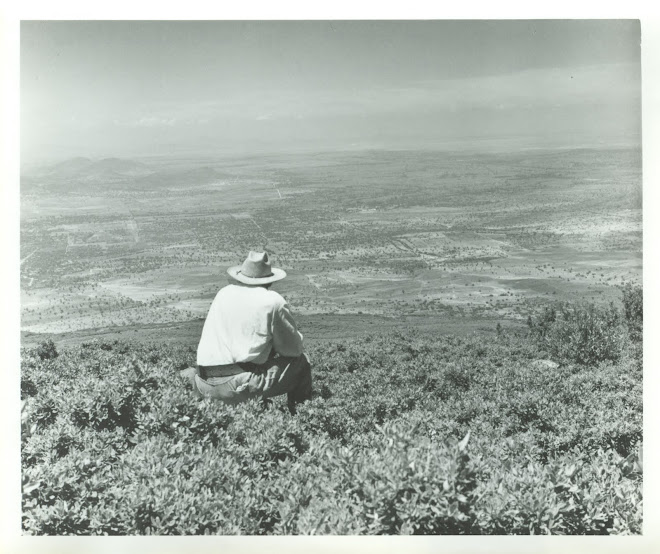




Trying to find our way up Mt. Malinal (Malinalco) Maria asked the military how to get there. Although they told us we couldn’t go through San Juan Teotihuacan, they told us to go through Cozotlan. We followed that road and started to go around and up mount Malinal. We drove on a dirt road through several ejidos and met Porfirio Medina who gave us permission to hike through his land (which was covered with nopal). He told us about the military fence that would not let us go all the way to the top. We hiked up until we found a water tank and a sign warning about the presence of breeding killer bees hives. We then proceeded quietly to take some pictures and decided to hike back down and encountered another hive of killer bees in a maguey that had been “castrated” for pulque production. We found another path that seemed to go around the mountain. We followed it and came to the military fence that went up the mountain again. We filmed from the top and also noticed springs as we hiked down. We then missed the path to the car and started walking in the appropriate direction. While walking we found a possible site, loaded with fine orange pottery and obsidian, and promptly recorded its location with GPS. We hiked up a tiny hill and found the location of the car. But to get to it we had to climb over a fence. We were spotted by someone who yelled at us and then saw a red pick-up truck hauling ass down the mountain towards us. We ran and jumped into the car and fled in our super Chevy Aveo.
We drove to San Juan to investigate the zocalo and get a beer. After locating one of the principle buildings from the original film, Maria noticed a bar across the street called La Especial. She remembered this name from one of the photographs. We walked inside and ordered micheladas. We began talking to the bartender, Oscar, and he told us that this bar had been here since 1942. We showed him a little of the footage and he was very impressed. He soon called the owner and told him what was going on. Moments later the owner of the bar, Don Luis Cano Garcia (aka “El Pollo”), walked in. He was shy at first but Maria went to talk to him. He immediately warmed up and told us that he remembered all the people from the Penn State project (Sanders, Charlie Fletcher, Joe Marino, Bill Mather, Barbara Price, and many more). He said there were 15 of them in all. He said that this was the bar they all hung out in everyday. He said, that in 1961 “La Especial” was an “elitist” bar. Only generals, captains, commanders, Spaniards, and Sanders were served here.
We showed Don Luis some of the footage and the entire bar became a buzz. Everyone was so excited to see their town of San Juan as it was 50 years ago. Don Luis even called the mayor, Senor Sanchez, on is cell phone. Turns out, the mayor is a relative of Juan Sanchez from Atlatongo. Don Luis also said doing a public showing of the film is a great idea and getting permission would not be an issue.
Next, Don Luis said he would have a party in our honor the next day starting at 12:30. He said he was going to invite a few other old timers. He agreed to be interviewed on camera. Hopefully we can interview several people. We did not tell Don Louis but have decided to show Land and Water at the bar and film people’s reaction. I am looking at this as an opportunity to show, on a much smaller scale, the reactions that people are going to have when they see the film at one of the public showings in August.
After having more drinks with Don Luis, the asshole that was with Ana Maria Vasquez (a nice lady who offered us a place to stay during the project) became extremely jealous and abrasive, insulting Maria and myself. He was beyond drunk and things started getting out of hand. We promptly closed our tab and told Don Louis that we would see him tomorrow.
An adventurous and productive day to say the least.
















